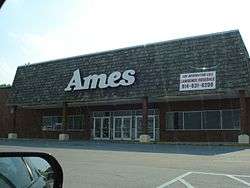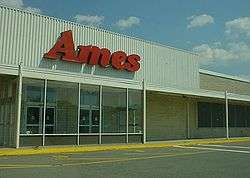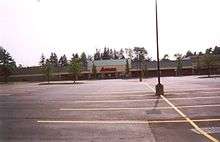Ames (store)
 | |
|
Department store, Private | |
| Industry | Retail |
| Fate | Bankruptcy and liquidation |
| Founded | Southbridge, Massachusetts; 1958 |
| Defunct | September 6, 2002 |
| Headquarters | Rocky Hill, Connecticut |
Number of locations | 700 in 1998 |
Key people | Joseph R. Ettore, Chairman and CEO |
| Products | Clothing, footwear, bedding, furniture, jewelry, beauty products, toys, electronics and housewares. |
| Website | AmesStores.com at the Wayback Machine (archived October 23, 1996) |
Ames was an American chain of discount stores based in Rocky Hill, Connecticut, United States. The company was founded in 1958 with a store in Southbridge, Massachusetts, and at its peak operated 700 stores in 20 states, including the Northeast, Upper South, Midwest, and the District of Columbia, making it the fourth largest discount retailer in the United States.
Despite some success in its later years, Ames was plagued by debt and a slow decline in sales. This resulted in two bankruptcy filings that ultimately put an end to the chain. The company, despite expanding into other markets and taking over many closed stores that had been abandoned by competitors, went out of business in 2002.
History

Ames began in 1958 when two Connecticut brothers, Milton and Irving Gilman, opened their first store in the Ames Worsted Textile Co. mill in Southbridge. The Gilmans simply used the old sign of the textile mill for the new business.
Ames' original business strategy brought discounting to the smaller towns and rural areas of the Northeast. The company's success in serving a largely rural customer base in smaller, less-competitive markets resulted in consistently strong financial performance and steady growth combining acquisitions and an aggressive store-building program through the late 1980s.
Many of the first stores were converted industrial sites, such as the first store in a former textile mill. Ames exploited the availability of cheap real estate in this manner in the first decades of the company, later moving to custom-built store facilities that provided standardized planning and marketing. Many Ames stores from the 1980s were the department store 'anchor store' for many discount mall developments.
Wave of expansion and first bankruptcy

Ames acquired the "Big N" chain from Neisner Brothers in November 1978. In 1984 Ames acquired the King's Department Stores chain and added most of its 193 stores to the fold. In 1985 Ames acquired G.C. Murphy of McKeesport, Pennsylvania, a chain that operated both discount stores and variety stores (the variety stores and many of the smaller G.C. Murphy discount stores would eventually be sold by Ames to McCrory Stores in 1989). Three years after the acquisition of G.C. Murphy Ames expanded further, acquiring the 392 store Zayre chain in 1988. Saddled with increased debt and hampered by the additional cost of converting those stores to Ames stores, the company suffered a significant reduction in profitability in late 1989 and early 1990. The Zayre chain also operated with stores concentrated in two distinct regions, the Northeast and Florida, which made coordination difficult.
In April 1990, Ames filed for bankruptcy protection under Chapter 11 of the U.S. Bankruptcy Code. One of the causes of the bankruptcy appeared to be Ames' policy of extending consumer credit to almost anyone who asked, without first checking their credit rating in an attempt to increase their market share. Ames had also replaced the Zayre credit card program with Visa cards that could be used anywhere Visa was accepted. This often resulted in their giving credit cards to customers who were already in debt to them, and they tended to attract high risk borrowers who tended to default on their debt payments. During their bankruptcy, Ames closed 370 stores.[1] It was also during this time that Ames changed their logo, trading in their traditional red and white colors for the green color present in Zayre stores; this eventually became an identifying mark of most Ames stores.
Emergence from bankruptcy and acquisition of Hills
After successfully emerging from bankruptcy on December 30, 1992, the company returned to profitability in 1993 and improved its operating performance. Net income increased to $17.3 million for 1996 (equivalent to $26.1 million in 2016) (fiscal year ended January 25, 1997), compared with a net loss of $1.6 million for fiscal 1995 (equivalent to $2.49 million in 2016). Income before other charges and gains for the fiscal 1996 year was $33.3 million (equivalent to $50.3 million in 2016), compared with $6.9 million in the prior fiscal year (equivalent to $10.7 million in 2016), a $26.4 million (equivalent to $39.9 million in 2016) improvement. During the 1990s, Ames was also known for moving into many former locations of their competitors. The chain added several Bradlees stores that were closed in the early part of the decade and opened 12 new stores in 1996, 11 of which were former Jamesway stores when that chain went out of business in late 1995.[2] Ames also took over several Caldor locations after their liquidation in 1999, as well as a few Montgomery Ward stores when that chain closed later that year.
With the acquisition of Hills Department Stores in 1998, Ames became the nation's fourth-largest discount retail chain behind Walmart, Kmart, and Target. Although Hills was headquartered in suburban Boston, its stores were concentrated in Indiana, Kentucky, Ohio, Pennsylvania, and western New York, which was a regional complement to Ames stores in the northeast. Then, Ames had just over 600 stores, mostly in the Northeast and Midwest, employing about 22,000.
Expansion into Chicago
In 2000, Ames moved into Chicago by acquiring all but one of the seven Goldblatt's department stores.[3] Other locations included former Venture and Builders Square stores, making for a total of 11 stores. The company hoped to target the low-income and ethnic consumer, using techniques that were proven successful. "The stores are generally on the South Side of Chicago, which has a low income base," a Ladenburg Thalmann analyst Beder said.[4] Before the opening day, a television marketing campaign showed cheery Ames employees working while singing "My Kind of Town," a song that strongly referred to Chicago. Billboards read, “Our Kind of Town, Your Kind of Discount Store”. On September 21, 2000, Ames opened eight of its Chicago stores and opened the others shortly thereafter. A few months later, Ames opened a few additional stores.
1999-2002: Second bankruptcy and demise

In March 1999, Ames closed eight stores. In November 2000, Ames closed 32 stores, with 31 of them being the newly acquired Hills. (Some of these closings had been anticipated, as these were considered the weakest of the Hills chain.) In August 2001, Ames closed another 47 stores. The company filed for bankruptcy protection for the second time on August 20, 2001. In November 2001, Ames closed 16 more stores and a distribution center. In December 2001, Ames closed 54 additional stores. Ames closed another six stores in June 2002, leaving the chain with 327 stores, about half of what they had in 1998.
On August 14, 2002, Ames' executives announced they would close the remaining 327 stores in the chain and wind down business, converting the chapter 11 bankruptcy reorganization to a chapter 7 bankruptcy liquidation.[5] “Continued softness in sales, combined with tightening terms and slower shipments from our suppliers, have reduced our funds availability below critical levels,” Ames' chairman and CEO Joseph R. Ettore, who had presided over the bankruptcy and liquidation of Stuart's and Jamesway prior to joining Ames, said about Ames' decision to go out of business. Analysts generally believe that debt related to the acquisition of Hills Department Stores, at the same time as the tightened credit markets of 2001, caused the bankruptcy. The increasing penetration of Walmart into the Northeast also made Ames' fate inevitable. In the Pittsburgh area, Target was already planning and had started an expansion into that area just as Ames was struggling, capitalizing on Ames' problems.
Because of the smaller size of many Ames stores, they have been difficult to convert to newer uses, and many times remain empty fixtures of small northeastern cities. Many of the smaller New England area stores have been taken over by Ocean State Job Lot, a Rhode Island-based closeout store. The store in Agawam, Massachusetts stood empty until being bought by local pet store owner Dave Ratner to expand the Agawam, Mass location of his store chain Dave's Soda & Pet City, of which Agawam is also the World HQ.
Despite the former Hills stores being larger, several former Ames in the Northern and Southern Steel Valley area remain empty. At the time of the liquidation, Ames' most profitable store had been in Ellwood City, Pennsylvania, in the Northern Steel Valley, which, at one point, had been a G. C. Murphy store - far enough from the nearest Walmart in either Youngstown or Warren or Kmart in New Castle to be convenient for locals. It has subsequently been one of the few former Ames' that has since been occupied and subdivided, with Peebles and Busy Beaver Hardware occupying the former Ames' site, with success.
Another well-performing Ames in Huntingdon, Pennsylvania has been subdivided into a Peebles and Sears Hometown Store.
Another former Ames store (previously Zayre) at the Belknap Mall in Belmont, NH has also been successfully subdivided, again with Peebles as the primary tenant along with a Big Lots Along with their Troy NY location. The former Ames store in Tilton, New Hampshire has been converted into a Smitty's Movie Cinema, and the short lived former Ames store in Kokomo, Indiana has since been occupied by Rural King. West Mifflin, Pennsylvania had two Ames stores, both previously Hills. One has been converted into a Big Lots (and retains the green Ames awnings) and the other has been subdivided into a gym and a Roses discount store.
The Ames store in Cressona, Pennsylvania has been converted into an out-patient surgery center, though the Ames sign remain inside the Cressona Mall (where the store was located) above the now unused mall entrance.
One other store in Hyde Park (Cincinnati,Ohio) had been converted into a Bigg's grocery store, followed by Remke's buyout of Bigg's.
A former Ames store located in the Buffalo suburb of Hamburg, New York was eventually converted into an Ollie's Bargain Outlet store.
The former Ames store in Pennsville, New Jersey is now home to a large thrift store after other businesses including an auction house and motorcycle shop failed to gain traction there.
An Ames store on Chicago's northwest side (1920 N Hamlin) was bought by the Chicago Board of Education, and a public middle school, "Ames Middle School", was built on the site.
Slogans
- "The savings are amazing at Ames" (mid 1970s)
- "The savings are amazing at Ames / Big N" (late 1970s)
- "You can believe in Ames" (Early 80s)
- "Amazing Ames!" (Early 80s)
- "It Pays to Shop at Ames... Every day." (Late 80s)
- "Where you come first... Every day." (Late 80s early 90s)
- "Ames. We grew up with better values." (Early 90s)
- "On your side." (Mid 90s)
- "Bargains by the Bagful." (1995-2002)
See also
References
- ↑ "Ames Cuts To Wipe Out Ex-zayres". Chicago Tribune, June 09, 1990.
- ↑ "Ames Department Stores Inc.". 1996-06-02.
- ↑ "Ames comes to Chicagoland; Midwestern market right mix". Discount Store News. 2000.
- ↑ "Ames comes to Chicagoland; Midwestern market right mix". Discount Store News. 2000.
- ↑ "Ames Discount Chain To Close". CBS News, February 11, 2009.